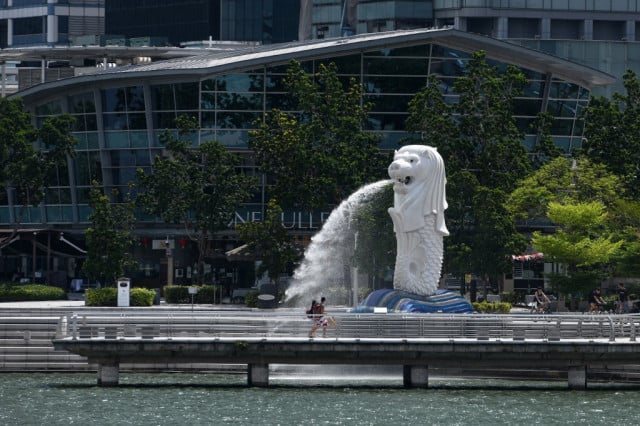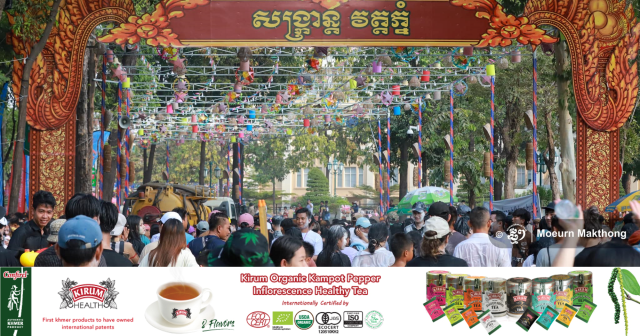Angkor Thom: the Khmer Empire’s Enclosed and Complex 12th Century City

- By Long Ton
- April 2, 2022 7:47 PM
The Angkor Thom City may be regarded as a holy city by tourists, students, researchers or believers from the moment they enter through the southern gate and then see the multiple temples grouped together at the core of the complex.
Aside from the bigger and marvelous historical sites of the Bayon and Baphuon temples, there are other sanctuaries such as the Preah Palilay temple, the Preah Pithu temple, the Khleangs and the West Prasat Top temple. These sanctuaries are perfect for those who long for peace and genuine quietness. And tourists can always feel free to perform athletic activities such as walking or cycling around the temples’ grounds.
Owing to the excellent renovation, the southern gate has become the most important among the five Angkor Thom gates and the crowd’s favorite to capture stunning pictures of the sculptures along the entrance.
At the southern causeway, there are huge and mighty stone figures standing to welcome us into the city. Looking upward, we can also see that the gate holds a four-faced statue that represents the four directions. Published researchers have suggested that the four-face statue is actually Bodhisattva Avalokiteśvara in Mahayana Buddhism (the Great Vehicle).
The entrance stone figures are commonly known as “Giants’ Tug of War,” which relatively connects to the Hindu myth of the “Churning of the Ocean of Milk.” The asuras, demons or titans occupy the right-hand side of the road whereas the devas and deities stand firmly on the left-hand side. Both groups of these immortal beings are standing as they pull a naga, which is a mythical semi-divine creature, as if it was a rope to obtain the amrit, elixir of immortality.
There also are towering and enormous trees guiding one along the way when traveling to the center of this former city. Nowadays, even though we can only see the thick and dark forest at the corners of this nine square-kilometer territory, if you can let your imagination roam back to the past, you will be amazed by how joyful and crowded this city could be.
But the beauty of the Angkor Thom city does not end there. If one keeps on walking to the top of the wall of this fortified city, it is nearly impossible to describe in words the breathtaking scenery with the moat filled with water and the surrounding tall trees. The square laterite fortress is 7.5 meters high and encloses an area of three kilometers on each of its four sides. Inside, the walls are reinforced with earth to form a solidified foundation. And this massive fortress has never failed to protect the Angkor Thom city from the late 12th century until present day.
Usually, people refer to this ancient city as Angkor Thom. At each corner of the city, a temple has been built on the earth embarkment. These small temples are called the Chrung temples.
Northwest of the Bayon temple stands the Baphuon temple, which was a religious sanctuary in the 11th century. Under restoration since 1943, it is only on July 3rd, 2011, that the temple was officially declared restored and opened to the public.
According to research, the Baphuon temple was constructed during the reign of King Udayadityavarman II. Every one of the mythical figures in the Baphuon is sculpted inside a square or rectangular frame depending on the storyline. Then in the 16th century, a giant image of the reclining Buddha was sculpted on the west side of the temple.
The compelling factor about this temple is the bridge that acts as an entry into the temple. This tends to spark questions among visitors who come to the Baphuon. Was this temple constructed amid a body of water? However, judging by the height of the staircase and the pond’s decorative stones in front of the temple, the area was not flooded at all.
From the temple, we can see a laterite compound that was the former royal palace north of the Baphuon. Inside this compound, besides the fascinating construction elements identified so far, the Phimeanakas temple remains standing beautifully. In the same area, there is the Srah Srei pond, or women’s bath, with steps and complex molding—the larger pond, or men’s bath, is located west of this pond. Finally, leaving the royal palace through the eastern gate will lead you to the king’s battlefield tent, which is known today as the “Terrace of the Elephants.”
According to inscription experts, the stone inscription number K. 292, which is engraved on the main doors and window frames, would actually be military oaths made at the start of the 11th century during the reign of Suryavarman I.
And what is fascinating is that, opposite the Terrace of the Elephants lies a road that leads to Angkor Thom city’s victory gate. Today, the spacious grounds in front are used for soldiers, people or massive gatherings.
Long Ton is a Cambodian with a passion for Angkor and that era. A university graduate who speaks several languages, he has conducted tours at Angkor.
Song Daphea contributed to the story















